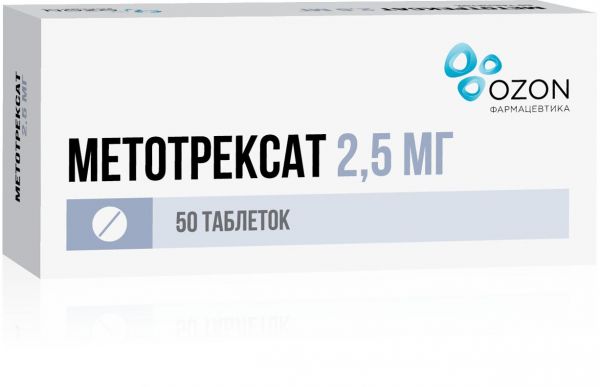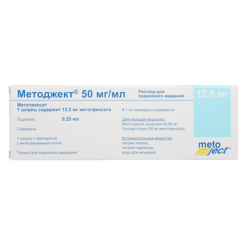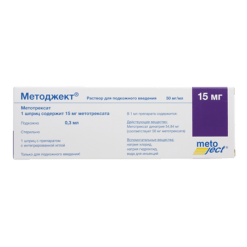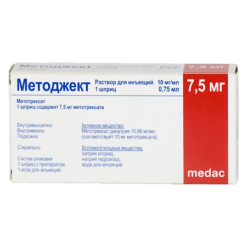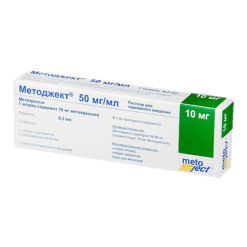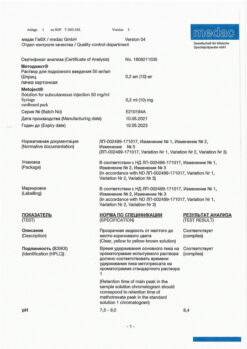No products in the cart.
Description
- acute lymphoblastic leukemia and non-Hodgkin’s lymphoma;
- trophoblastic tumors;
- Fungal mycosis in advanced stages.
- Fungal mycosis in advanced stages;
- severe forms of psoriasis;
- rheumatoid arthritis (when other therapies fail).
.
Indications
Indications
Acute lymphoblastic leukemia and non-Hodgkin’s lymphomas;
trophoblastic tumors;
mycosis fungoides in advanced stages;
severe forms of psoriasis;
rheumatoid arthritis (if other methods of therapy are ineffective).
Special instructions
Special instructions
Methotrexate is a cytotoxic drug and must be handled with caution. The drug should be prescribed by a doctor who has experience in the use of methotrexate and is familiar with its properties and characteristics of action. Due to the possible development of severe and even fatal adverse reactions, patients should be fully informed by their physician about the possible risks and recommended safety measures. Patients receiving methotrexate therapy should be closely monitored to ensure that signs of potential toxicity and adverse reactions are identified and assessed promptly.
Before starting or resuming therapy with methotrexate, a complete general blood count should be performed to determine the level of platelets, a biochemical blood test to determine the values of liver enzymes, bilirubin, serum albumin, a chest X-ray examination, a kidney function test, and, if necessary, tests for tuberculosis and hepatitis.
For timely detection of symptoms of intoxication, it is necessary to monitor the state of peripheral blood (the number of leukocytes and platelets: first every other day, then every 3-5 days during the first month, then once every 7-10 days, during remission – once every 1-2 weeks), the activity of “liver” transaminases, kidney function (urea nitrogen, creatinine clearance and/or serum creatinine), uric acid concentration in blood serum, periodically perform fluoroscopy of the chest organs, examination of the oral mucosa and pharynx for the presence of ulceration before each use. It is recommended to monitor the state of bone marrow hematopoiesis before treatment, once during the treatment period and at the end of the course.
Methotrexate may potentially lead to the development of symptoms of acute or chronic hepatotoxicity (including liver fibrosis and cirrhosis). Chronic hepatotoxicity usually develops after long-term use of methotrexate (usually for 2 or more years) or a total cumulative dose of at least 1.5 g and can lead to an adverse outcome. The hepatotoxic effect may also be due to a burdened concomitant medical history (alcoholism, obesity, diabetes mellitus) and old age. Due to the toxic effects of the drug on the liver, during treatment you should refrain from prescribing other hepatotoxic drugs to patients unless clearly necessary. Patients taking other hepatotoxic drugs (eg leflunomide) should be closely monitored.
To objectify liver function, along with biochemical parameters, it is recommended to perform a liver biopsy before or 2-4 months after the start of treatment; with a total cumulative dose of 1.5 g and after each additional 1-1.5 g. For moderate liver fibrosis or any degree of cirrhosis, methotrexate therapy is discontinued; For mild fibrosis, a repeat biopsy is usually recommended after 6 months. During initial therapy, minor histological changes in the liver (minor portal inflammation and fatty changes) are possible, which is not a reason to refuse or discontinue treatment, but indicates the need for caution when using the drug
If diarrhea and ulcerative stomatitis develop, methotrexate therapy must be interrupted due to the high risk of developing hemorrhagic enteritis and perforation of the intestinal wall, which can lead to the death of the patient.
Do not expose unprotected skin to too much sunlight or overuse a UV lamp (a photosensitivity reaction is possible). Due to its effect on the immune system, methotrexate may worsen the response to vaccination and affect the results of immunological tests. It is necessary to refuse immunization (unless it is approved by a doctor) in the interval from 3 to 12 months after taking the drug; other family members living with the patient should refuse immunization with oral polio vaccine (avoid contact with people who have received the polio vaccine or wear a protective mask covering the nose and mouth). Patients of childbearing potential of both sexes and their partners should use reliable contraception during treatment with methotrexate and after treatment for at least 3 months in men and at least one ovulation cycle in women.
After a course of treatment with high doses of methotrexate, the use of calcium folinate is recommended to reduce its toxicity.
Impact on the ability to drive vehicles and other mechanisms that require increased concentration
Since methotrexate can have an effect on the central nervous system (fatigue, dizziness), patients taking the drug should refrain from driving vehicles or potentially dangerous machinery.
Active ingredient
Active ingredient
Methotrexate
Composition
Composition
1 tablet contains:
Active substances:
methotrexate 2.5 mg.
Excipients:
sugar (sucrose) – 43.97 mg,
potato starch – 21.82 mg,
talc – 680 mcg,
calcium stearate – 340 mcg,
crospovidone – 340 mcg,
povidone – 350 mcg.
Shell composition:
sugar (sucrose) – 32.5865 mg, magnesium hydroxycarbonate hydrate – 20.457 mg, wheat flour – 16.144 mg, povidone – 166 mcg, gelatin – 138 mcg, azorubine dye (E122) (carmoisine, acid red dye 2C) – 16.6 mcg, titanium dioxide – 450 mcg, wax – 27.9 mcg, talc – 14 mcg.
Contraindications
Contraindications
The use of methotrexate is contraindicated:
during pregnancy and lactation;
with pronounced changes in kidney and liver function;
for hematological disorders (such as bone marrow hypoplasia, leukopenia, thrombocytopenia, anemia);
in the acute stage of infectious diseases;
with immunodeficiency syndrome;
with hypersensitivity to methotrexate or other components of the tablet;
children under 3 years old.
With caution: with ascites, effusion into the pleural cavity, gastric and duodenal ulcers, ulcerative colitis, dehydration, gout or nephrolithiasis in history, previous radiation therapy or chemotherapy, infectious diseases of a viral, fungal or bacterial nature.
Side Effects
Side Effects
From the hematopoietic system: anemia (including aplastic), thrombocytopenia, leukopenia, neutropenia, agranulocytosis, eosinophilia, pancytopenia, lymphoproliferative diseases, hypogammaglobulinemia, lymphadenopathy.
From the digestive system: anorexia, nausea, vomiting, stomatitis, gingivitis, pharyngitis, enteritis, erosive and ulcerative lesions and bleeding from the gastrointestinal tract (including melena, hematemesis), hepatotoxicity (acute hepatitis, fibrosis and cirrhosis of the liver, liver failure, hypoalbuminemia, increased activity of “liver” transaminases), pancreatitis.
From the nervous system: headache, dizziness, drowsiness, dysarthria, aphasia, hemiparesis, paresis, convulsions; when used in high doses – transient impairment of cognitive functions, emotional lability; unusual cranial sensitivity, encephalopathy (including leukoencephalopathy).
From the organ of vision: conjunctivitis, visual impairment (including transient blindness).
From the cardiovascular system: pericarditis, pericardial effusion, decreased blood pressure, thromboembolism (including arterial thrombosis, cerebral vascular thrombosis, deep vein thrombosis, retinal vein thrombosis, thrombophlebitis, pulmonary embolism).
From the respiratory system: rarely – pulmonary fibrosis, respiratory failure, alveolitis, interstitial pneumonitis (including fatal), chronic obstructive pulmonary disease (COPD), symptoms of potentially serious interstitial pneumonia – dry non-productive cough, shortness of breath, fever.
From the genitourinary system: severe nephropathy or renal failure, azotemia, cystitis, hematuria, proteinuria, impaired spermato- and oogenesis, transient oligospermia, decreased libido, impotence, dysmenorrhea, vaginal discharge, gynecomastia, infertility, miscarriage, fetal death, fetal development defects.
From the skin: erythematous rash, skin itching, urticaria, photosensitivity, skin pigmentation disorders, alopecia, ecchymosis, telangiectasia, acne, furunculosis, erythema multiforme (including Stevens-Johnson syndrome), toxic epidermal necrolysis, ulceration and necrosis of the skin, exfoliative dermatitis. When treating psoriasis – a burning sensation of the skin, painful erosive plaques on the skin.
From the musculoskeletal system: arthralgia, myalgia, osteoporosis, osteonecrosis, fractures.
Neoplasms: lymphoma (including reversible).
General reactions: allergic reactions up to anaphylactic shock, allergic vasculitis, tumor lysis syndrome, soft tissue necrosis, sudden death, life-threatening opportunistic infections (including Pneumocystis pneumonia), cytomegalovirus (CMV) infections (including CMV pneumonia), sepsis (including fatal), nocardiosis, histoplasmosis, cryptococcosis, infections caused by Herpes zoster and Herpes simplex (including disseminated herpes), diabetes mellitus, excessive sweating.
Interaction
Interaction
Increases the anticoagulant activity of coumarin or indanedione derivatives and/or increases the risk of bleeding by reducing the synthesis of a procoagulant factor in the liver and impairing platelet formation.
Increases the concentration of uric acid in the blood, therefore, when treating patients with concomitant hyperuricemia and gout, dose adjustment of anti-gout medications (allopurinol, colchicine, sulfinpyrazone) may be required; the use of uricosuric anti-gout drugs may increase the risk of developing nephropathy associated with increased formation of uric acid during treatment with methotrexate (preferably allopurinol). Concomitant use of salicylates, phenylbutazone, phenytoin, sulfonamides, sulfonylurea derivatives, aminobenzoic acid, pyrimethamine or trimethoprim, a number of antibiotics (penicillin, tetracycline, chloramphenicol), indirect anticoagulants and lipid-lowering drugs (colestyramine) increases toxicity due to displacement methotrexate from connection with albumin and/or a decrease in tubular secretion, which in some cases can cause the development of severe toxic effects, sometimes even fatal.
Non-steroidal anti-inflammatory drugs (NSAIDs) in combination with high doses of methotrexate increase the concentration and slow down the elimination of the latter, which can lead to death from severe hematological and gastrointestinal intoxication. It is recommended to stop taking phenylbutazone 7-12 days, piroxicam 10 days before, diflunisal and indomethacin 24-48 hours before, ketoprofen and NSAIDs with short T1/2 12-24 hours before infusion of methotrexate in moderate and high doses and for at least 12 hours (depending on the concentration methotrexate in the blood) after its completion. Caution should be exercised when combining NSAIDs with low doses of methotrexate (reduced renal tubular excretion of methotrexate is possible). Medicines that block tubular secretion (for example probenecid) increase the toxicity of methotrexate by reducing its excretion by the kidneys.
Antibiotics that are poorly absorbed from the gastrointestinal tract (tetracyclines, chloramphenicol) reduce the absorption of methotrexate and disrupt its metabolism due to suppression of normal intestinal microflora.
Retinoids, azathioprine, sulfasalazine, ethanol and other hepatotoxic drugs increase the risk of developing hepatotoxicity.
L-asparaginase reduces the severity of the antitumor effect of methotrexate by inhibiting cell replication.
Anesthesia using dinitrogen oxide can lead to the development of unpredictable severe myelosuppression and stomatitis.
The use of cytarabine 48 hours before or within 10 minutes after the start of methotrexate therapy may cause the development of a synergistic cytotoxic effect (adjustment of the dosage regimen is recommended based on monitoring hematological parameters).
Hematotoxic drugs increase the risk of developing methotrexate hematotoxicity.
Methotrexate reduces theophylline clearance.
Oral neomycin may reduce the absorption of methotrexate. Several patients with psoriasis or mycosis fungoides treated with methotrexate in combination with PUVA therapy (methoxsalen and ultraviolet irradiation (UV)) have been diagnosed with skin cancer.
Combination with radiation therapy may increase the risk of bone marrow suppression. Methotrexate may reduce the immune response to vaccination with live and inactivated viral vaccines.
Folate-containing medications (including multivitamins) may reduce the effectiveness of methotrexate therapy.
Administration of amiodarone to patients receiving methotrexate therapy for psoriasis may cause skin ulceration.
Overdose
Overdose
There are no specific symptoms of methotrexate overdose; it is diagnosed by the concentration of methotrexate in plasma.
Treatment: Administration of a specific antidote – calcium folinate, if possible immediately, preferably within the first hour, in a dose equal to or higher than the dose of methotrexate; subsequent doses are administered as needed, depending on the concentration of methotrexate in the blood serum.
To prevent precipitation of methotrexate and/or its metabolites in the renal tubules, the body is hydrated and the urine is alkalinized, which accelerates the excretion of methotrexate. To minimize the risk of nephropathy resulting from the formation of sediment of the drug or its metabolites in the urine, it is necessary to additionally determine the urine pH before each administration and every 6 hours throughout the period of use of calcium folinate as an antidote, until the plasma concentration of methotrexate is below 0.05 µmol/L, to ensure a pH above 7.
Storage conditions
Storage conditions
Store in a place protected from light at a temperature not exceeding 25°C. Keep out of the reach of children.
Shelf life
Shelf life
3 years.
Manufacturer
Manufacturer
Ozon, Russia
Additional information
| Shelf life | 3 years. |
|---|---|
| Conditions of storage | Store in a light-protected place at a temperature not exceeding 25°C. Keep out of reach of children. |
| Manufacturer | Ozon, Russia |
| Medication form | pills |
| Brand | Ozon |
Other forms…
Related products
Buy Methotrexate, 2.5mg 50 pcs. with delivery to USA, UK, Europe and over 120 other countries.

